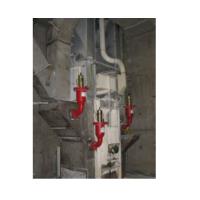 Add My Company
Add My Company
Sign In

Different kinds of elevators
Most widespread is the two leg type elevator with inside a moving belt on which buckets are attached that transport the product upwards and, due to the centrifugal force, throw out the product at the head. Some variants are:
The one-leg elevator: both the upgoing and the down going belt are situated in the same leg.
The Z-elevator: an elevator with, before and behind, a horizontal part. This kind of elevator turns at a much lower speed and is used especially when merely a small transport capacity is needed.
Explosive mixtures and clouds in elevators
If an elevator is used for the transport of powders, one must take into account the more or less permanent presence of an explosive mixture. In the case of granules it is not always a matter of an explosive mixture, but of deposits that, due to vibrations or shocks, may easily be set free and generate an explosive cloud.
Ignition sources in elevators
The most likely ignition sources in elevators are those caused by mechanical problems: wall friction or slippage can lead to the generation of sparks or hot surfaces able to ignite an explosive mixture. But ignition sources, in the form of glowing parts, can come along with the product.
Protect your elevators
Elevators must always be equipped with preventive systems: slippage and out of line detection, together with non-return breaks. In spite of this, mechanical problems cannot always be excluded with sufficient certainty, and additional protection will be necessary. All the more as elevators often feed silos causing the consequences of an explosion being disproportionately big.
Explosion venting for your elevator
If your elevator is located outside, or close to an outside wall, in general explosion venting is applied. We will determine how many rupture discs are necessary:
For products with a low Kst-value there is hardly any flame acceleration: a rupture disc near the head and an other near the boot are in such a case sufficient.
With higher Kst-values rupture discs are needed at regular distances from each other. These distances depend on the kind of product (the Kst-value) and on the elevators strength. Applying the HSE model this distance can be calculated.
Inappropriate application of the HSE model
Sometimes this HSE model is not an option:
The flame accelerations in an elevator are often limited as the space inside the legs is for a great deal filled up by the elevator buckets. In the case of small buckets in a large leg (e.g. in the case of elevators with round legs) the free volume around the buckets is much larger and the flame acceleration will also be higher and the HSE model cannot be applied just like that.
If a bursting disc with integrated flame extinguisher is used instead of a standard rupture disc, the first will get clogged as a result of prolonged blowing off. So in this case too, the HSE model cannot be applied.
Explosion suppression for your elevator
If you apply explosion suppression, you can take advantage of the fact that an explosion, in an elevator, nearly always starts in the head or in the boot. In the case of explosion suppression in nearly all cases the following equipment will do:
(pressure)detection on head and boot
explosion suppression on head and boot
chemical barriers on both legs, near head and boot.
Especially in case of very high elevators this has great advantages, because a lot of scaffolding, necessary for the installation and maintenance of the rupture discs, can be avoided. Because of this, explosion suppression of elevators is often applied, even if, in view of the location, explosion venting would be perfectly possible. Sometimes though, in such cases combinations are applied. For instance: the explosion suppression on the head is replaced by explosion venting, whilst the chemical barrier is maintained.
Complete protection of your elevator
Inlet and outlet
It is obvious that, both in the case of explosion venting and in the case of explosion suppression, both the inlet and the outlet of the elevator have to be protected against propagation. For this purpose in most cases rotary valves or chemical barriers are applied. Often, at the head and/or the boot, there is also an exhaust system present. Here also isolation is necessary: a chemical barrier or, if so desired, a fast shutting valve.
Chemical barriers
Chemical barriers can often be combined. If an extinguishing agent bottle with multiple outlets is used, it may be applied for both legs together. Dependant on the dimensions and the distances, sometimes one bottle can be used for both legs, an inlet and an exhaust tube.
Ignition source detection
As in an elevator an explosive mixture is not always present, it is not certain that, in the case of spark generation or overheating, there will be an explosion immediately. If an elevator is protected by explosion suppression there is no guarantee whatsoever that, out of the elevator, no smouldering material will be transported into a silo. For this reason, in many cases it is strongly advised to install an additional ignition source detection on the elevator outlet, combined with the possibility to stop and/or remove the smouldering material.
For more information on Elevators: safe vertical transport. talk to StuvEx Safety Systems Ltd
Enquire Now
More related to Elevators: safe vertical transport.
List your company on FindTheNeedle.
